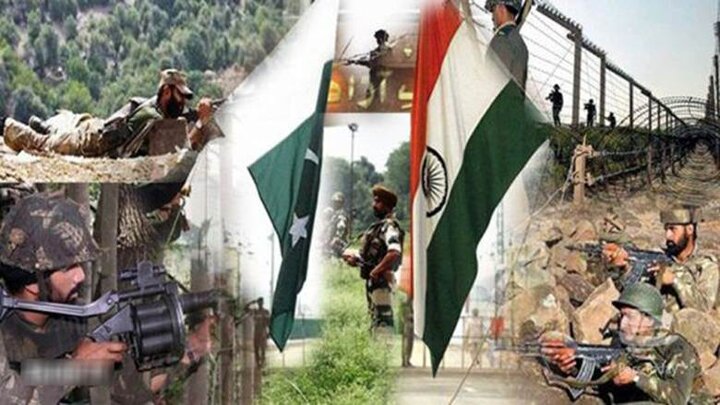Kashmir on the Brink: Will India and Pakistan Escalate to Military Confrontation?

Bloody Attack on Tourists in Pahalgam Reopens Kashmir’s Old Wounds,Pushing strained India-Pakistan Relations to the Brink of explosion; Will Nuclear Powers Clash Amid diplomatic Silence?
Mehr News Agency,International Desk: Following Tuesday’s deadly terrorist attack (April 22) in Indian-administered Kashmir,diplomatic and security tensions between New Delhi and Islamabad have sharply escalated. The assault, which occurred in the Baisaran area near Pahalgam, left 26 dead—mostly Indian tourists—and over 20 others injured.after the attack, a statement attributed to The Resistance Front (TRF) claimed duty. Some analysts suggest the group is a faction of Pakistan-based Lashkar-e-Taiba. The statement linked the violence to India’s issuance of thousands of residency permits for non-Kashmiris, allowing them to settle in the disputed region.However, the accuracy of this statement has not yet been confirmed, and Pakistan has denied any connection to these elements or the terrorist act.
The disputes between these two neighbors have a long history. As the independence of India and Pakistan in 1947, relations between them have been marked by distrust, military conflicts, and ideological rivalries. the longstanding conflict over jammu and Kashmir has been the primary cause of four wars, dozens of border clashes, and numerous diplomatic crises. This rivalry has not only taken on a military dimension but also political, cultural, and economic aspects—dragging both countries into a highly tense path where any provocative incident could escalate into a full-blown crisis.
!“Kashmir” in the Line of fire; Will India and pakistan Enter a Phase of Military Confrontation?Over the past two decades,tensions such as the 2001 attack on the Indian Parliament,the 2008 Mumbai attacks,and border clashes in 2016 and 2019 (which led to airstrikes and the downing of a fighter jet) have demonstrated that relations between New Delhi and Islamabad have always teetered on the edge of crisis.Meanwhile, periodic diplomatic efforts have often been derailed by terrorist incidents or political developments in either country.
Against this backdrop,the deadly attack days ago in Pahalgam reignited tensions once again. Indian officials, citing links between the assault and groups based in Pakistan, launched retaliatory measures and political threats—actions that were met wiht responses from Pakistan.
India’s Hardline Policy Toward Pakistan: From Suspending Treaties to Redefining Borders
In the immediate aftermath of the terrorist attack in Pahalgam, India’s government adopted a tough stance…Pakistan’s official map has been accused of supporting terrorism in the Kashmir region. India’s Ministry of External Affairs, by issuing a statement, indicated that this move was likely linked to groups operating from Pakistani soil.Shortly afterward, Pakistan’s ambassador to India was summoned by the Ministry of External Affairs and handed a formal protest note.
Indian Prime Minister Narendra Modi described the act as ”barbaric” during a televised address and vowed that India would give a “stern and merciless” response. He added with unusual sharpness that not only would those behind the attack be held accountable, but their supporters would also be pursued “wherever they are in the world.” These remarks clearly carried a message for Pakistan, which has long been viewed by Delhi as a haven for semi-military groups.
In an earlier move, the Indian government announced it had suspended its obligations under the “Indus Waters Treaty,” citing violations. This treaty, established in 1960 between India and Pakistan under World Bank mediation, governs water-sharing rights over six rivers flowing through both countries. The suspension signals escalating tensions between the two nuclear-armed neighbors over Kashmir—a region both claim in full but control only partially.Under the supervision of the World bank, one of the limited cooperation agreements between two countries was signed.The signing of this agreement was perceived as a strategic threat by Pakistan, as three vital rivers (Jhelum, Chenab, and Indus) originate from India and supply water to this country.
Similarly, India labeled all exported goods for Pakistani citizens as contraband and wholly halted movement through the attari-Wagah border crossing.The government also instructed all diplomatic and military personnel stationed at the Indian embassy in Islamabad to leave Pakistan instantly.Indian media swiftly adopted a harsh tone against Islamabad, with public opinion within the country also demanding an official response.
Pakistan’s Response to India’s Provocation: From Denial to Reciprocal Action
The Pakistani government promptly denied reports of any opposed actions following news of alleged aggression while expressing solidarity with affected families. It categorically rejected any involvement in the incident. The Ministry of Foreign Affairs…Pakistan issued a statement condemning the attack in Islamabad, describing it as an act contrary to human values.
At a higher level, Pakistan’s Defense Minister Khawaja Asif made controversial remarks, calling the Pahlgam attack a “false flag” operation and claiming it could have been orchestrated by India itself to justify further suppression in Kashmir or divert public attention from domestic challenges. These statements provoked a sharp reaction from New Delhi, sharply inflaming media tensions between the two countries.
Additionally, in response to India’s retaliatory measures, the Pakistani government implemented a series of countermeasures.As an initial step, visa issuance for Indian citizens was suspended, and Indian airline flights were barred from Pakistani airspace. This decision disrupted several international routes from India to Europe and West Asia,sparking discontent in buisness circles of both nations.
In another highly symbolic move, Pakistan announced…India has suspended the Shimla Agreement, a key document in managing bilateral disputes. Signed after the 1971 war between the two countries, the agreement emphasized peaceful resolution of issues, including Kashmir.Its implicit annulment could signify a significant reduction in diplomatic channels between the two nations.
In response, Pakistan’s government warned that any indian attempt to divert water from shared rivers—particularly under the Indus Waters Treaty—would be considered a hostile act and a direct threat to Pakistan’s national security. Senior Pakistani military officials also announced heightened readiness of their forces while reiterating their desire to avoid escalation. Despite this official stance, public sentiment in Pakistan has grown defensive and apprehensive.
Bilateral,Regional,and International Implications of Current Tensions
The potential consequences of escalating tensions…The relations between India and Pakistan can be analyzed within three frameworks: bilateral,regional,and international consequences.
!“Kashmir” in the Line of Fire; will India and Pakistan Enter a Phase of Military Confrontation?
1. Bilateral Consequences (India – Pakistan)
Recent tensions have pushed the fragile relations between India and Pakistan to the brink of complete rupture. the suspension of key treaties such as the Indus Waters Treaty and the Shimla Agreement signifies the collapse of two major pillars of mid-term diplomacy between these nations. Additionally, the expulsion of diplomats, closure of official borders, and cancellation of visas indicate the beginning of a “new Cold War” between these nuclear-armed neighbors in South Asia. this situation has directly harmed cross-border trade, cultural cooperation, civilian movement, and even sporting events.On the security front, these tensions could lead to sporadic clashes along the Line of Control (LoC) in Kashmir. past experiences (such as the crises of 1999 and 2019) have shown that heightened verbal tensions often coincide with increased cross-border firing and limited military operations.If this trend continues, the risk of miscalculations or unanticipated clashes will rise.
2. Regional Implications (South Asia)
South Asia, particularly neighboring countries like Afghanistan, Nepal, Bangladesh, and sri Lanka, has always been vulnerable to crises between India and Pakistan. Any instability in relations between these two nations could negatively impact regional security, trade, and projects such as China’s Belt and Road Initiative or energy and transit projects in Central Asia.
Additionally, pressure on regional organizations like SAARC will intensify…The organization had previously become semi-active due to disputes between India and Pakistan, and now, with rising tensions, it will be completely sidelined. The strategic rivalry between these two countries may also force smaller nations to take sides or increase their dependence on one of the major powers.
3. International Consequences of Escalating Crisis
The international community, particularly global powers such as the U.S.,China,Russia,and the European Union,is concerned about the escalating conflict between these two nuclear-armed nations.These tensions are seen not only as a direct threat to regional stability but also to global security. The U.S. and Britain have issued statements urging restraint, while China has cautiously called on both sides to resolve disputes through dialogue.
Increased military tensions in South Asia could also impact global markets—particularly…In the energy sector, Asian financial markets and the insurance industry have seen fluctuations. On another note, these developments have once again drawn international attention to the Kashmir issue, perhaps increasing pressure on the United nations Security Council to formally address this historic dispute.
Final Remarks
Recent events indicate that India-Pakistan relations are caught in a cycle of recurring tensions—marked by distrust and mutual accusations—stemming from border disputes. Each time a bloody incident occurs, it sparks fierce political rhetoric, ultimately leading to a breakdown in diplomatic relations despite initial efforts at de-escalation. The latest missile strike was not merely a humanitarian tragedy but also a severe blow to decades of bilateral agreements and fragile diplomatic ties.
At the regional level, escalating tensions between these two nuclear-armed neighbors risk destabilizing South Asia as a whole. Countries like Afghanistan, Nepal, and Bangladesh could face spillover effects from prolonged instability…Under the influence of geopolitical shifts in the quasi-region, China’s conditions appear to be pushing it toward redefining its foreign policies. Similarly, the intensification of security rivalries could threaten economic projects and regional cohesion with serious risks.
ultimately, until a stable mechanism emerges for managing relations between India and Pakistan—and as long as both countries remain entrenched in past tensions without shifting their positions—each new advancement could mark the beginning of a darker ancient chapter. The global community, too, must move beyond repetitive statements and play a more active role in facilitating dialogue and restoring rationality to relations between these two neighbors. Or else, from an observer’s perspective, no region in an interconnected world can remain confined to its borders indefinitely.


